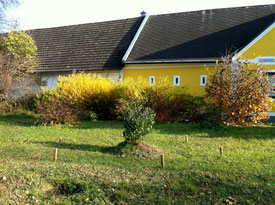- DEUTSCH
- ENGLISH
- SUCHE / SEARCH
Instead of bringing the oleanders into a protected place, we’re bringing protection to the oleanders.
For this long-term experiment, we started out with the presumption that there would be some successes and some failures. I have written about frost tolerance and microclimates in another article of mine. Let it just be mentioned here that basically, oleanders will withstand frost, and also that for the purpose of hardening them off, they should be kept outside as long as possible. However, once temperatures reaching as low as -5 C (23 F) are forecast, it’s time to bring them inside for the winter.
Here, however, the subject is overwintering oleanders which have been planted in a fixed location, and where there is a true winter with ice and snow, frosts lasting for weeks on end, and low temperatures reaching -20 C (-4 F) or lower.
We know that in Mediterranean countries, oleanders are living within their own native region; if ice or snow should occur in wintertime, it will only be of short duration. Oleanders are accustomed to this, or at worst, they will incur only minor damage. In Central Europe, oleanders are treated as container plants and are brought indoors to a protected place. Nurseries can accomplish this professionally with greenhouses and polytunnels, or the growing plants may live entirely under glass. Private oleander enthusiasts bring their “pets” into solariums, garages, stairwells, and even cellars. Oleanders would not last through one of our winters.
Where we are located: Südburgenland, in southeast Austria, Central Europe.
Our climate is “blessed” with 300 days of sun per year; summers can be hot, almost Mediterranean, but they can also be rainy. Late summer is usually stable.
Winter can be cold, very cold; not in the sense of alpine cold as in the mountain regions, but rather in the sense of high-pressure systems blowing in from the East. There is hardly any of the warming Atlantic influence which is experienced in Central Germany (although that lies to the north). During the winter of 2011/2012, for example, there were three weeks of lingering frost in February with a series of clear nights and temperatures of -20 degrees C (-4 F)!
The players in this series of experiments are all older specimens and are NOT distinguished by any particular frost hardiness: Splendens Giganteum, Mont Blanc, and Géant des Batailles (Commandant Barthélémy). But they are vigorous, among the best-known and widely-distributed varieties, and are therefore well-suited as examples for comparison. Besides, I have enough of them.
Oleanders in the yard area along a south-facing wall

In the yard, along the southern wall of an outbuilding under a pergola, the above-mentioned cultivars (Splendens Giganteum, Mont Blanc, and Géant des Batailles [Commandant Barthélémy]) were planted in the spring of 2012 (see the right side of the photo). The soil is loamy/sandy, mixed with building rubble. In the building there is only one large room which serves as a workshop and an oleander-overwintering area; it is only slightly heated. The oleanders under the arcade will eventually be brought indoors for the winter and are of older stock. Small plants have already been moved inside. It is November 17, 2012; there have already been some light nighttime frosts. The pots are somewhat protected with towels.
Our longest experience (20 years!) has been with this location, along the sheltered house wall.
More details on this in the DOCUMENTATION . . .
Oleanders along the front side of the main house

Along the south side of the main house, there is one oleander each to the left and right of an unused entryway. Formerly in pots, there were planted directly into the ground as bushes in the spring of 2011. The soil in this location is humus-rich. The oleander on the left stands in a niche and is more sheltered. The one on the right stands right at the corner of the house; it is more exposed to any winds and is therefore less protected.
The dried-up plants in the foreground are only partially dry – they are frozen. These are marigolds (Tagetes), which freeze even in temperatures slightly below the freezing point. This well illustrates that there has already been a nighttime frost. It is November 17, 2012.
To the DOCUMENTATION . . .
Oleanders planted out in a field

This location is the most interesting one, and the main subject of our experiments. The meadow in which the oleander bush is planted is located between the yard area of my own house and that of the neighbor’s. The location is wide-open and, being north-south in orientation, is exposed to weather and wind – the two properties together act as a blast-pipe. The soil actually consists only of building rubble; a onetime flat drinking trough for cows, which would fill up with rainwater, was filled in at some point with this construction waste. Even now, the slightly sunken area will exhibit standing water for days during long rainy periods in the summer or when the snow melts in late winter.
Since the spring of 2011, two bushes have stood there: Splendens Giganteum and Mont Blanc. They were not planted into the ground per se; they were simply placed on the surface and had soil heaped around them. They rooted optimally during the 2011 season.
Even here, the frost has not yet had any effect; the photo was taken on November 17, 2012.
To the DOCUMENTATION . . .



